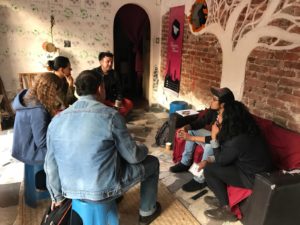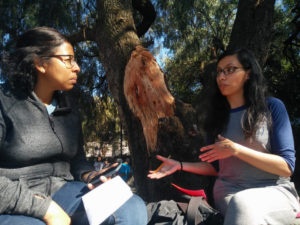(Written by Eliana Maria Osorio Saez, PhD Candidate in the Department of Education)
For four weeks last November and December, I visited Mexico City with my second supervisor, Andres Sandoval, and colleague, Jo Davies, as part of the University Bath team for the project “A poetry-focused art intervention in schools and marginalized neighbourhoods”.
The aim for this stage of the project was to implement an intervention in the schools and it involved an impact evaluation of a poetry workshop co-created by the Mexican partners. Thus, the University of Bath team collected information on the expected outcomes before and after the poetry workshop took place. Data was collected through questionnaires, observations, field notes, and interviews. One school was classified as a ‘treatment’ school while the other one was the ‘control’ school. Information was collected from both but the workshop was carried out in the treatment school before the second questionnaire.
The two secondary schools which were focus of the intervention are located in Iztapalapa. This delegación is composed by a group of neighbourhoods, also called “colonias” with more than 1.800.000.000 inhabitants and it is considered one of the most dangerous areas in the city; it is known as a hostile place.
After getting settled, we met Anelvi, an extraordinary woman who has devoted the last five years to work for the city government office called Alas & Raices. Anelvi and her teammates support arts projects in schools for teenagers in marginalised neighbourhoods, and also supported us during our time in Mexico City, providing logistics, advice and plenty of creative ideas during the project implementation.
Anelvi welcomed us and walked us through the Santa Maria de La Ribera, a historical neighbourhood west of the city centre and home of the Poesía & Trayecto, a group of friendly, young and outgoing poets. This group of poets was our third partner in this project, and responsible for delivering the poetry workshops in the schools. Together with Roman, a street artist, in charge of painting a mural, all of them joined us for this first meeting. For almost two hours, we discussed and agreed on responsibilities, logistics and actions for the poetry in tervention. Ideas about arts, poetry, the power of words, data collection methods and research objectives aligned perfectly to begin next day with the implementation of this project.
tervention. Ideas about arts, poetry, the power of words, data collection methods and research objectives aligned perfectly to begin next day with the implementation of this project.
During our first visit to the schools we explained the strategy to the head teachers and they described the school context with a focus on student and family characteristics. One of the head teachers even apologised in advance for any inappropriate behaviours we could witness during our time in the school.
Phase one of the intervention within both schools involved the first application of the questionnaire. This tool would measure students´ perception of their schools and neighbourhoods, as well as their own potential to change this perception.
After the first questionnaire, in the treatment school, the Poesia & Trayecto poets did a flash mob in each classroom, it consisted of a spontaneous poetry performance to motivate students to sign up for the poetry workshops.
We expected to register 30 students for the workshop in the treatment school and we ended up having 90 in total, so there was a need to invite a fourth poet and divide the large group into small groups. The fact that students registered voluntarily for the activity made it easy to reach the goals for each creative session.
Individual and collective poems were created by the students; they wrote them on pieces of paper that were collected by the poets in order to design and publish a book to be handed out to each participant during the closing event.
D uring the last two days of the intervention, Roman, the street artist and a group of approximately 20 students, painted a wall where the ideas expressed within the poems were represented. Students in charge of painting queued for one hour to wait for their turn to paint, they seemed very enthusiastic and creative.
uring the last two days of the intervention, Roman, the street artist and a group of approximately 20 students, painted a wall where the ideas expressed within the poems were represented. Students in charge of painting queued for one hour to wait for their turn to paint, they seemed very enthusiastic and creative.
On the last day of the intervention a public event was held. Students read their poems aloud from the printed book to their teachers, other students and some parents.
Students were asked to complete the questionnaire a second time to observe differences in their perceptions post intervention.
After four weeks in Mexico City filled with exciting activities, spicy food and wonderful conversations with inspiring partners, and with the vivid images of young people smiling proudly after seen their poems printed on a book, we returned home with plenty of ideas for the next steps in this project. We will back in May to present results to the partners in Mexico City.
Respond



